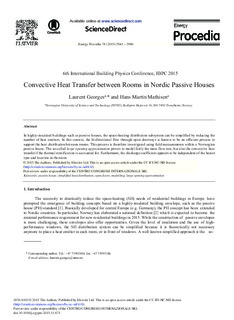| dc.contributor.author | Georges, Laurent | |
| dc.contributor.author | Mathisen, Hans Martin | |
| dc.date.accessioned | 2016-10-04T14:46:11Z | |
| dc.date.accessioned | 2016-10-10T08:59:03Z | |
| dc.date.available | 2016-10-04T14:46:11Z | |
| dc.date.available | 2016-10-10T08:59:03Z | |
| dc.date.issued | 2015 | |
| dc.identifier.citation | Energy Procedia 2015, 78:2941-2946 | nb_NO |
| dc.identifier.issn | 1876-6102 | |
| dc.identifier.uri | http://hdl.handle.net/11250/2413814 | |
| dc.description.abstract | In highly-insulated buildings such as passive houses, the space-heating distribution subsystem can be simplified by reducing the number of heat emitters. In this context, the bi-directional flow through open doorways is known to be an efficient process to support the heat distribution between rooms. This process is therefore investigated using field measurements within a Norwegian passive house. The so-called large opening approximation proves to model fairly the mass flow rate, but also the convective heat transfer if the thermal stratification is accounted for. Furthermore, the discharge coefficient appears to be independent of the heater type and location in the room. | nb_NO |
| dc.language.iso | eng | nb_NO |
| dc.publisher | Elsevier | nb_NO |
| dc.rights | Navngivelse-Ikkekommersiell-IngenBearbeidelse 3.0 Norge | * |
| dc.rights.uri | http://creativecommons.org/licenses/by-nc-nd/3.0/no/ | * |
| dc.title | Convective Heat Transfer between Rooms in Nordic Passive Houses | nb_NO |
| dc.type | Journal article | nb_NO |
| dc.type | Peer reviewed | nb_NO |
| dc.date.updated | 2016-10-04T14:46:11Z | |
| dc.source.volume | 78 | nb_NO |
| dc.source.journal | Energy Procedia | nb_NO |
| dc.identifier.doi | 10.1016/j.egypro.2015.11.673 | |
| dc.identifier.cristin | 1319839 | |
| dc.description.localcode | © 2015 The Authors. Published by Elsevier Ltd. This is an open access article under the CC BY-NC-ND license. | nb_NO |

